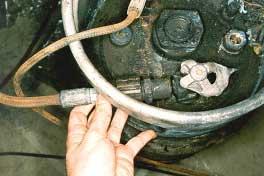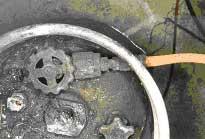Sequence of events
The balloon pilot and his two passengers were conducting a private flight as part of the Canberra balloon festival. The balloon's equipment included three aluminium liquefied petroleum gas (LPG) fuel cylinders, dual burners, three radios, a motorcycle-type lead-acid battery, an altimeter and a variometer. After completing a normal flight, the pilot prepared to land the balloon on an area of parkland. This area was relatively small, with large trees on the approach and a street and houses in the direction of flight. Following the touchdown, as the balloon envelope continued to travel, the basket gradually tipped over and the pilot pulled the ripline to deflate the envelope. At about that time, the occupants of the basket noticed a fireball in the basket and immediately evacuated. Witnesses described the flames as yellow. The pilot stated that he let go of the ripline and allowed the balloon to ascend, deciding that it was safer for the fuel cylinders to be in the air than on the ground surrounded by bystanders. Witnesses heard an explosion and saw an object fall from the remains of the basket. The fire continued to burn, and subsequently consumed the wicker basket and damaged the lower panels and skirt of the envelope. Debris from the balloon fell across three suburbs and damaged several houses. The remains of the balloon were subsequently found 1.6 km from the initial landing point.
The pilot of the balloon was wearing a hat, a short-sleeved cotton shirt, trousers, gloves and shoes. He sustained serious burns to his forearms, face and neck. The male passenger was wearing a woollen lumberjack-style long-sleeved shirt, jeans, gloves, boots, sunglasses and a hat. He sustained minor burns to his face and wrists and was the only occupant not admitted to hospital. The female passenger was wearing running shoes, three-quarter length pants, gloves and a long-sleeved top which did not tuck into the waistband of her pants. She sustained serious burns to her shins and stomach.
Wreckage examination
An examination of the wreckage of the balloon established that two aluminium fuel cylinders were each connected to one of the two burners. One tank was connected by both the vapour feed line and the liquid feed line, while the other was only connected by the vapour feed line. Both pilot-light valves were on, the cross-feed valve was off and both the liquid and vapour offtake valves on both fuel cylinders were on. It was also noted that a male connector fitting had broken off flush with the top of the threaded portion of the body of the corresponding fuel cylinder liquid offtake valve.
Further examination of the broken fitting showed that it had been partially fractured when the fire developed. The fracture was sufficiently large to allow the uncontrolled escape of LPG into the balloon's basket. The fracture surfaces indicated that the fire was no longer burning near the fracture at the time the fitting broke away completely. The fitting had fractured in a downward direction, and there was no evidence of fatigue or pre-existing defects.
One aluminium fuel cylinder was found along the debris trail between the initial landing site and the final location of the remains of the balloon. This cylinder had failed because of a single ductile rupture of the upper shell section, characterised by a large bulged area, outwardly turned fracture lips and extensive blackening and sooting around the rupture.
Pilot light usage
The balloon manufacturer's Flight Manual section 4.6 'Landing', stated that the pilot light should be turned off before touchdown. Some balloon pilots indicated that they sometimes left the pilot lights on for landing if they were certain that the balloon basket would not tip over, allowing them to conduct a go around if required. Once the pilot lights were turned off, if insufficient height was available to relight the pilot lights, a pilot would normally be prevented from conducting a go around before the balloon touched down.
Fuel cylinder fitting selection
The broken fitting consisted of a Rego 8101P5 service valve coupled to a 7141M check connector. With this configuration, the assembly extended outside the fuel cylinder guard ring.
A comparison of the Rego 8101P5/7141M combination liquid offtake valve (left), and the Rego 8180 valve (right), and their relationship to the fuel cylinder guard ring
The balloon manufacturer's maintenance manual stated that "only factory supplied parts and materials are permitted to be used for repair or maintenance actions". The manufacturer advised that they previously supplied the Rego 8180 valve, but now supplied the BMV 344 handwheel-type liquid offtake valve in place of the Rego 8180 valve. The BMV valve was similar to the Rego 8180 valve. Balloon industry personnel suggested that while the Rego 8180 valve was the most widely used fitting, the Rego 8101P5/7141M combination was also relatively widely used in ballooning applications.
While the balloon manufacturer's documentation provided guidance regarding selection of fuel cylinder fittings, general practice among balloonists was for gas supply companies to replace, if required, fuel cylinder fittings during the mandatory 10-yearly cylinder inspection. Gas supply company personnel generally have extensive experience and knowledge regarding fuel cylinder maintenance, but they do not normally have much involvement in the aviation industry. They are not provided with detailed guidance regarding the appropriate selection and configuration for fuel cylinder fittings for aviation applications.
The investigation did not establish who had installed the Rego 8101P5/7141M combination liquid offtake valve.




